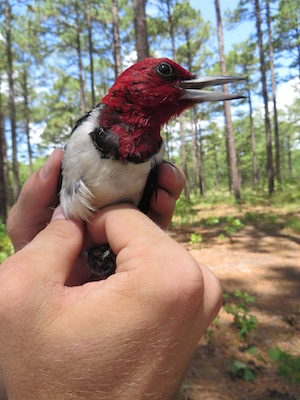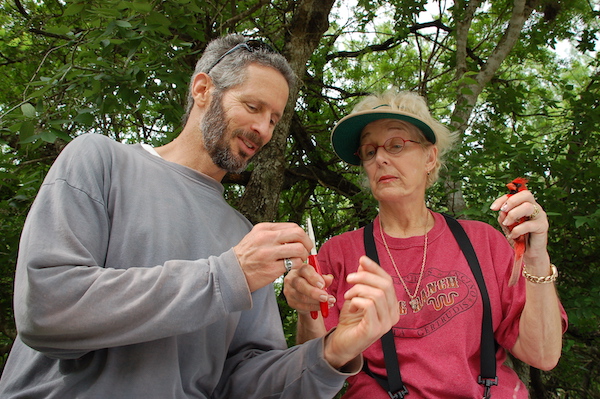Ron Taylor is one of IBP's bird banding gurus and a data wrangler extraordinaire. He serves as IBP's primary verifier of MAPS bird banding data, meaning he carefully vets the data to make sure all the data fields for a given bird capture record are complete, reasonable, internally consistent, and consistent with other capture records of the same bird. Ron also recruits, trains, and supervises IBP's MAPS field crews and teaches bird banding courses.

Ron banding Black-capped Vireos in Texas for The Nature Conservancy back in 2003.
How and when did you get interested in birds?
Back in 1984, during my last quarter at Humboldt State University, after taking Ornithology 1 and not being particularly captivated by birds, I reluctantly took Ornithology 2 so I could graduate. Doc Harris' enthusiasm for birds was so infectious that I was hooked after the first field trip.
What is your favorite bird to band?
Cedar Waxwings. They have so many things to look at and measure (rather than keying in mainly to the primary coverts and secondary coverts), they're colorful, and impossibly soft.
Bird you'd most like to band but haven't caught yet...
That's a tough question because any bird in the hand for the first time is amazing. During the 2004-05 season, I had crews in both Georgia and North Carolina. In Georgia, there were often Red-headed Woodeckers near the nets but not IN the nets. When one finally ended up being banded, I was in North Carolina. That would have been a good bird.
What is your favorite part about teaching bird banding?
Seeing people go from being nervous and tentative while extracting a bird from a mist-net, to getting more confident and efficient at removing birds safely.

Someday Ron will get his Red-headed Woodpecker.
You never go banding without...
My Swiss Army knife.
What do you like about data verification?
Pretty much every data-set has errors and inconsistencies. I really enjoy running the data through our verification programs to find and fix as many of the errors as I can. Records where a good resolution isn't found are flagged to be left out of anayses. That gives us a lot of confidence in our verified data.
What kind of errors do you find and fix in the MAPS bird banding data?
The first goal of verification is to make sure that all records from the year being looked at make sense on their own or are internally consistent. For instance if the record says the bird's skull only has a trace of ossification (recorded as skull=1), then age should be hatch year (recorded as age=2). When all current-year records are "clean", we add all records from previous years and make sure that all captures of an individual bird are consistent as to species and sex. We also make sure that the age is the same in any given year, and progresses in a nice chronological order if the bird has been caught in multiple years. Errors that can have a big impact on the data are mis-read or mis-entered band numbers. Those are often found by a program we run that checks to make sure a recapture record has an original banding record somewhere in the past. Another program points out when the same band number has been recorded as being two different species, or the same species, but different sexes.

Getting ready for a trip out onto Tomales Bay to see the bioluminescence. Photo by Lauren Helton.
How is this summer different for you given that banding training classes have been canceled?
I'm doing more verification. :)
Do you have any hobbies/activities you enjoy?
I've been a competitive swimmer all my life. I swam on the same team from age 5 to 20 in age-group swimming, and have been competing in Master's swimming for 30 years. I also like to take my sea kayak out on San Francisco Bay.
(Ron does not toot his own horn, but IBP will: Ron is frequently in the top ten nationally for his Masters swimming competitions.)
What's your favorite bird to watch and why?
Pretty much any hummingbird. They're acrobatic, colorful, and not at all shy.






